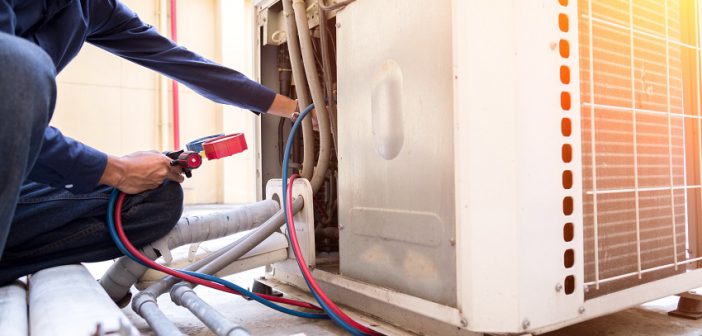Do you want to know how to add refrigerant to your air conditioner? For security concerns and because of the technical knowledge gained, it is normally recommended to have a professional add a new refrigerant to the system.
But if you want to do it yourself, you should follow the steps listed in this guide. If you need additional assistance, check this article.
Steps to follow to add new refrigerant
When the refrigerant levels are low, the air conditioner will drop the performance levels and stop cooling the environment. In general, the refrigerant is contained in a closed circuit, so the level should stay the same.
However, in case of leaks, the AC system will lose refrigerant. Therefore, it is always good to find new leaks and seal them before refilling the refrigerant.
Here are the main steps to follow:
1. Check if your system needs refrigerant
The first thing to check is if the system requires a new refrigerant in the first place. The signs that your air conditioner needs to be refilled are the following:
- The AC is blowing warm air
- There is ice in the coil
- Water on the floor or leaking
Warm air coming out of the air conditioner is one of the first signs of a problem with the refrigerant, but it could also be a thermostat problem. You can figure that the refrigerant is the issue because the air produced by the AC unit will get even warmer.
In addition, if you see ice on the coils, it is possible that there is a leak and that the AC system is losing refrigerant. Another sign to look for is water coming out from the air conditioner.
Water is dripping because of the condensation, or the ice formed around the coil is melting (which is another sign of low refrigerant levels).
2. Seal any leaks
Now that you know that the refrigerant needs to be refilled, before doing it, it is vital to find all the leaks and seal them. Otherwise, the new refrigerant will get out of the system, and you will have warm air again coming out of the air conditioner.
Finding and sealing leaks is better done by a qualified technician who can perform a full inspection of the AC unit and locate the leaks. In general, the leaks are located by finding the areas of low pressure, which indicate the zones where the leaks are situated.
You can attach a repair kit to the system and follow the instructions if you wish to repair the leaks yourself.
3. Get your refrigerant supply
Check your air conditioner manual or label to determine which refrigerant is necessary for your unit. You can also get a reusable injection hose, a sealant, and a pressure and temperature gauge.
4. Turn off electricity
Turn off the air conditioner, the thermostat, and the breaker. Ensure that the system is not actively connected to an electricity source, since it can be dangerous to operate otherwise.
5. Get protection
During the procedure, you should wear gloves, goggles, and a mask to prevent getting in contact with the refrigerant since it can be toxic.
6. Connect the refrigerant gauges to the right valve
Attach the correct hose to the valve to refill the refrigerant. You should connect or reconnect the refrigerant gauges to the system and connect the refrigerant tank using the proper hoses.
Once everything is connected correctly, you can release the valve with the refrigerant container and let the refrigerant flow into the AC unit.
The gauges are there to tell you when the AC has reached the proper temperature (which you have to find in the system manual or the system label) and, therefore, when to stop the refill.
7. Test the system
Once you have added the correct amount of refrigerant (using the gauges to determine the right quantity), do a test run of the system for around 20 minutes and check if the air conditioner is now cooling the house.
At this point, if everything is fine, detach the gauges and the hoses. If there is still something wrong, it is possible that you need to add more refrigerant, or there are still leaks to be found and sealed.
Can I recharge the refrigerant by myself?
Refilling the refrigerant is not so difficult, but it is a pretty technical operation. It is always possible to buy the correct refrigerant and the equipment necessary to perform a successful recharge. Still, it can be challenging and even dangerous without a bit of knowledge of an AC unit.
If you do not feel very comfortable doing it yourself, it is better to have a qualified technician operating to prevent unwanted system damage or even accidents.
In addition, if you try to recharge the refrigerant when it is unnecessary, you could damage the system. For example, overcharging the system can damage the AC’s compressor, or the system can even break down completely.
But, an unnecessary recharge can warm the coils and create unexpected frosting. Therefore, recharges are not supposed to be done often; they are a rare occurrence, mainly because of the presence of leaks.
This is why a technician would be more prepared to find out what is the actual state of your system and advise on the proper strategy to fix any problem.
For example, maybe the concern is not the refrigerant, or you could miss finding all the leaks; a professional can figure this out and much more.
Conclusion
If you believe your air conditioner needs to be recharged, you can try DIY or follow this guide. However, if you do not like dealing with technical issues, it is better to have a trained technician do it.
Before replacing the refrigerant, trained and experienced professionals can perform a comprehensive maintenance on your air conditioner and identify concerns that aren’t yet visible. If you need assistance with your air conditioner, don’t hesitate to contact us.





Thank you for sharing! Maintaining a sufficient amount of refrigerant is important for the effective operation of the unit.